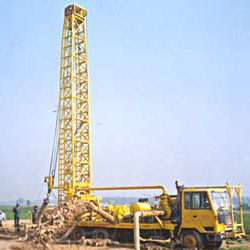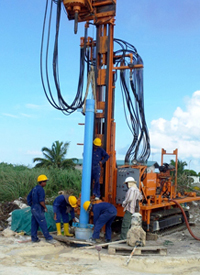We offer services for tubewell drilling with our capacity of drilled water well up to a maximum of 27 inches in diameter, and up to 1500 feet depth. We cater to varied different types of drilling of varied formulations. Our organization has successfully executed work on some of the most difficult underground formations in India. With the aid of our infrastructural set up, we have executed the works in most of the areas with the maximum capacity.
Some of the jobs handled by our team includes:
(1). Domestic tubewells up to 12” in diameter are construction and installation on site by our engineers
(2). Pressurized water supply systems including filtration and UV treatment are available on request
 Reverse circulation is achieved by blowing air / water down the rods, the differential pressure creating air lift of the water and cuttings up the inner tube which is inside each rod. It reaches the bell at the top of the hole, and then moves through a sample hose which is attached to the top of the cyclone. The drill cuttings travel around the inside of the cyclone until they fall through an opening at the bottom and are collected in a sample bag.
Reverse circulation is achieved by blowing air / water down the rods, the differential pressure creating air lift of the water and cuttings up the inner tube which is inside each rod. It reaches the bell at the top of the hole, and then moves through a sample hose which is attached to the top of the cyclone. The drill cuttings travel around the inside of the cyclone until they fall through an opening at the bottom and are collected in a sample bag.
RC drilling is air-powered, water is also used, to reduce dust, keep the drill bit cool, and assist in pushing cutting back upwards, but also when collaring a new hole. A mud called liquid-pol is mixed with water and pumped into the rod string, down the hole. This helps to bring up the sample to the surface by making the sand stick together. Occasionally, 'super-foam' (AKA 'quick-foam') is also used, to bring all the very fine cuttings to the surface, and to clean the hole. When the drill reaches soil, a collar is put down the hole around the rods which is normally PVC piping. Occasionally the collar may be made from metal casing. Collaring a hole is needed to stop the walls from caving in and bogging the rod string at the top of the hole. Collars may be up to 60 meters deep, depending on the ground.
Reverse circulation rig setups usually consist of a support vehicle, an auxiliary vehicle, as well as the rig itself. The support vehicle, normally a truck, holds diesel and water tanks for resupplying the rig. It also holds other supplies needed for maintenance on the rig. The auxiliary is a vehicle, carrying an auxiliary engine. These engines are connected to the rig by high pressure air hoses. Although RC rigs have their own booster and compressor to generate air pressure, extra power is needed which usually isn't supplied by the rig due to lack of space for these large engines.
Direct Rotary Drilling Services In the direct-mud rotary drilling method, the borehole is advanced by rapid rotation of a drill bit mounted on the end of the drill rods. The bit cuts and breaks the material at the bottom of the hole into small pieces (cuttings). The cuttings are removed by pumping drilling fluid (water or water mixed with a fluid enhancer, such as bentonite) down through the drill rods and bit and up the annulus between the borehole and the drill rods. The drilling fluid also serves to cool the drill bit and stabilize the borehole wall, to prevent the flow of fluids between the borehole and surrounding earth materials, and to reduce cross-contamination between aquifers.
In the direct-mud rotary drilling method, the borehole is advanced by rapid rotation of a drill bit mounted on the end of the drill rods. The bit cuts and breaks the material at the bottom of the hole into small pieces (cuttings). The cuttings are removed by pumping drilling fluid (water or water mixed with a fluid enhancer, such as bentonite) down through the drill rods and bit and up the annulus between the borehole and the drill rods. The drilling fluid also serves to cool the drill bit and stabilize the borehole wall, to prevent the flow of fluids between the borehole and surrounding earth materials, and to reduce cross-contamination between aquifers.
Despite these obstacles, direct-mud rotary drilling can be the best alternative, especially for deep wells or wells completed into well-lithified rocks. When direct-mud rotary methods are used, hole diameters should be 3 inches to 5 inches larger than the outer diameter of the well casings to allow effective placement of filter and sealing materials. Two-inch diameter monitoring wells should, therefore, be installed within 5.5-inch or larger holes.
Tubewell Drilling ServicesWe M/s hitech drilling engineers take pride to introduce ourselves as a service provider in the field of tube well drilling and rain water harvesting. We offer comprehensive project execution service like tube well drilling, rain water harvesting, sales, service and installation of submersible pump throat India. Our business operation is done directly thought most proficient architects and consultant. Our service has always catered to the requirement of our customers.
Development Of Tube Wells The company is equipped with 1100 to 450 CFM and 150 to 600 PSI capacity compressors for development of tube wells. The 550 CFM at 600 PSI, compressor has been introduced for the first time in India, in tube well industry for quick and effective development of tube wells of depth up to 1500 ft. by direct lowering of air line. In addition the tube wells are developed by submersible pumps to make the discharge silt free. Step draw down test is conducted to determine operational discharge and well efficiency. Last year new screw air compressor of 1100 CFM @ 350 PSI was also introduced for the first time in drilling industry.
The company is equipped with 1100 to 450 CFM and 150 to 600 PSI capacity compressors for development of tube wells. The 550 CFM at 600 PSI, compressor has been introduced for the first time in India, in tube well industry for quick and effective development of tube wells of depth up to 1500 ft. by direct lowering of air line. In addition the tube wells are developed by submersible pumps to make the discharge silt free. Step draw down test is conducted to determine operational discharge and well efficiency. Last year new screw air compressor of 1100 CFM @ 350 PSI was also introduced for the first time in drilling industry.












